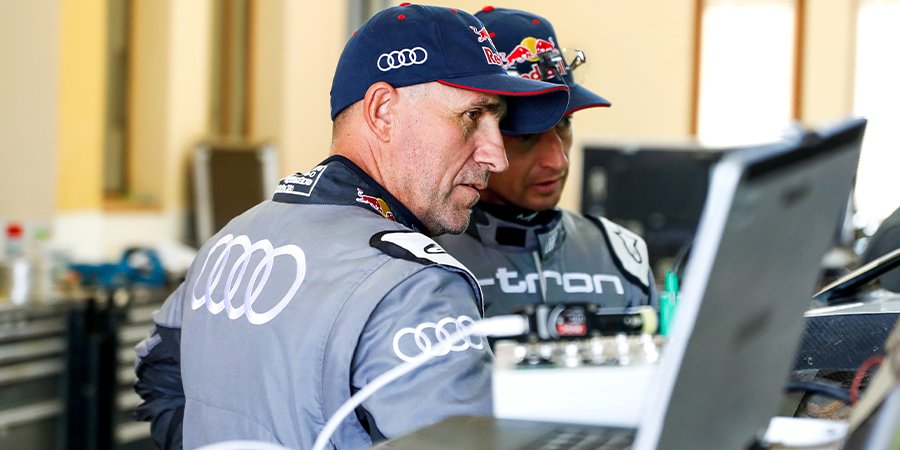Neuburg a. d. Donau, December 7, 2021 – Looking inside the Audi RS Q e-tron, every fan will be reminded of an airplane cockpit: screens and displays spread across the entire width of the dashboard. It is only with their help that the driver and co-driver can travel thousands of kilometers quickly and successfully in the desert.
Initially, there was a clear division of labor in off-road rallying: the driver drove and the co-pilot navigated. These roles have long since changed: regulations limit navigation tasks to very precise options and rules. The route’s previous paper route booklet is now digital. With its operating concept, the Audi RS Q e-tron redistributes various functions between driver and front passenger.
Steering, acceleration and braking are the main tasks for Mattias Ekström, Stéphane Peterhansel and Carlos Sainz, who are preoccupied with the terrain. You no longer need to change gears, as the electric drive with energy converter in the Audi RS Q e-tron no longer requires a manual gearbox. The twin-crank aluminum handbrake lever is located in the center of the cockpit. It is combined with an innovative brake-by-wire system that combines hydraulic braking with an energy recovery system. Therefore, using the handbrake helps to regain energy, just like using the footbrake. But the real purpose of the rally handbrake is to get the RS Q e-tron to coast ahead of corners. Instantaneous locking of the rear wheels forces the car to spin. This makes changes in orientation particularly flexible.

There are eight control buttons on the steering wheel, located directly in front of the driver. Among other things, they can control the horn, windshield wipers and data entry in the software if the driver wants to store time-stamped exceptions in memory. The speed limiter can also be activated there for areas where the maximum speed is specified. The display is located directly behind the steering wheel below the driver’s field of vision. It provides information on tire pressure, driving direction selected by the continuously variable electric drive (forward, reverse or neutral) and current speed. It also includes important warnings so that the driver can react immediately if, for example, the system is about to shut down or the high-voltage battery is disconnected. Two small displays mounted above and on the windshield show basic information: the so-called repeater on the left shows the compass direction, while the one on the right shows the speed of travel.
A central display located between the driver and front passenger provides information on tire pressure, selected brake balance, the brake-by-wire system and many other functions. Information is highlighted in green when a function or system is working properly, and in red when an error occurs. Below is a control panel. Individual keys respond to touch pressure points. Audi stores various functions in 24 freely assignable but predefined zones: for example, a preselected top speed (as is usual in speed-limited zones) or climate control. Different pages can be programmed so that the 24 keys can be assigned multiple times. Less commonly used functions can be accessed on the back. For example, in the event of damage, individual systems can be shut down here (“fail safe”) to safely reach the stage destination during emergency operations.
The passenger is responsible for operating this control panel; the driver simply expresses his will. All must run as smoothly as possible for hours in rough terrain at speeds of up to 170 km/h. Therefore, the co-pilot has a high degree of responsibility in addition to the initial primary navigational task. “Right now I only spend half my energy on navigating and the other half on operating the car. But I love this new challenge,” says Edouard Boulanger, co-pilot of Stéphane Peterhansel.

The route of the upcoming stage is no longer issued the evening before as in the past. The teams only receive this route information 15 minutes before the start of the stage each morning. Emil Bergkvist, who shares the cockpit with Mattias Ekström, sees this as an advantage: “As a driver, I come from classic sprint rallying. For me, this is the ideal time to switch to cross-country rallying as a co-driver, because now even the established co-drivers have to get used to these new rules.”
Short-term information on routes and the transition to digital Roabook format presented significant challenges. To find their way through the terrain while sticking to the assigned route, the three co-pilots Emil Bergkvist, Edouard Boulanger and Lucas Cruz looked at two tablet screens, replacing the previous paper road books. It operates via two remote controls connected by a cable. On the left side of the screen, the road book shows the route through the station. Staff can only open and use the sealed paper road book provided if the tablet fails, or face penalties. The tablet on the right contains GPS navigation and verifies the digital waypoints each participant must navigate to. When the car is within the radius of the waypoint, the driver will also see an arrow in the right repeater under the windshield indicating the direction to the waypoint.
The biggest difference to the navigation systems in production cars: While the device helps find the destination as accurately as possible in road traffic, navigating off-road rallying is still a sporting challenge. Aside from the performance of the driver, it’s make or break. The organizer only provides basic directions, distances, pictograms, special functions and hazard warnings in the road book. Therefore, GPS systems in rally cars are of limited help to teams. At the same time, the system acts as a control tool for the organizer. In this way, he can check whether the participants are adhering to the route and speed in the speed control zone in hundreds of kilometers of open terrain.
Only the Iritrack system in the center console completes the cockpit. It is used for first aid in emergency situations. The organizer records speed, current vehicle position and can identify possible accidents. In an emergency, the co-pilot can directly tell the host if the passenger is safe, if medical assistance is needed, or if the rescue team should help other participants in the accident. In the state-of-the-art cockpit of the Audi RS Q e-tron, maximum precision, speed and a large number of tasks characterize digital work. In cross-country rallying, however, it’s also human Factors that determine the success of a sport.

